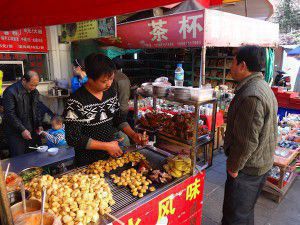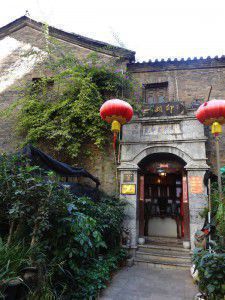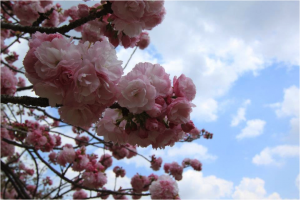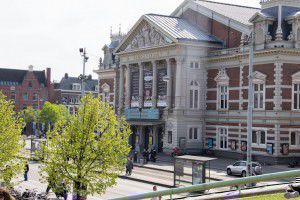10 reasons to visit… China
China is an amazing country, one that should be on every traveler’s must visit list. Few countries possess the wide variety of experiences you will find in the Middle Kingdom. While you are in this amazing country, be sure to visit the province of Yunnan, one of the lesser known, but most beautiful destinations within China. Here are ten terrific reasons why you should visit China, by Anna Smith, who studies Chinese in China at Keats School.
1. Breath-taking landscapes
As one of the largest countries in the world, China boasts incredibly diverse landscapes. Virtually whatever scenery you find most beautiful, you will find it in China. From the Northwest deserts to the Southeast seacoast, high mountain ranges to fertile plains, the frozen beauty of Harbin to the lush warm tropics of Xishuangbanna, China has it all. Hangzhou is famous for its stunning West Lake views. Suzhou has beautiful garden views and winding rivers with traditional architecture. And Hainan is the tropical paradise of the Orient; known as the ‘Eastern Hawaii’; it is China’s own paradise island.
2. Wonderful people
As the most populous nation in the world, China has plenty of people to meet. Chinese people generally love Westerners, so most are quite friendly. Everywhere we go, people want to stop and chat and take pictures with us. You can meet some amazing people and hear many intriguing life stories in the Middle Kingdom.
3. Awesome language
To a native English speaker, Mandarin can seem intimidating because it is so different to European languages. But this uniqueness makes it all the more beautiful and amazing to experience. Chinese characters are stunningly beautiful. Listening to tonal Mandarin can be like experiencing a new kind of music for the first time. If you already playing with the thought of challenging yourself, then you should definitely check out these reasons to study Chinese at Keats School.
4. Incredible food
While known for its tea and rice, there is much more to Chinese cuisine than is commonly known by most Westerners. And this cuisine varies greatly by region. In the north, noodles are the most common meal staple, but in the south, almost everything is served over rice. Different regions, like Sichuan and Hunnan, are known for their unique spicy food, while coastal regions boast a variety of seafood. Some of the most fun and interesting foods to try are street foods, such as roasted sweet potatoes and Chinese barbecue, shao kao.
5. Rich history
Few places have such a vast and rich history as the Middle Kingdom. The Great Wall of China and the Terracotta Warriors are some of the most well known ancient tourist attractions. The Forbidden City and Temple of Heaven in Beijing are also must-see attractions to learn about Chinese history and culture.

Royal Palace, Lijiang. Ancient traditional buildings can still be easily seen in many cities in China.
6. Modern development
At the same time, China boasts some of the largest cities in the world and is becoming more modern everywhere you look. Nowhere else have I ever seen so many high rises or amazing skylines as in China. Shanghai epitomises modern day China, with the famous modern riverfront skyline known as the Bund, large European style buildings, and its particularly distinctive Pearl of the Orient tower.
7. Amazing markets and exciting products
True, China makes a wide variety of products that are exported all over the world, but they have many unique products as well. Fine silks, exquisite China tea sets, elaborately carved jade, and expensive aged tea are some of the most sought after high-priced commodities. But Chinese Calligraphy, bamboo baskets, traditional Chinese knots, and other handcrafted items are distinctly beautiful as well. Provinces in the southwest of China have a wide variety of unique items hand crafted by the many minorities within its borders.
8. Fascinating diversity
One of the most amazing things about China is the variety of experience that can be enjoyed in one place. Old and new, sweet and spicy, rough and smooth, all combine into a rich cultural tapestry. Because of its ethnic and topographical diversity, Yunnan holds incredible diversity in one province.
9. Mind-blowing memories
Because there are so many unique and diverse things to experience, a trip to China is sure to create some incredible memories. These experiences will travel with you for the rest of your life. My family and I have experienced so many wonderful memories. Especially exciting to my young boys are eating jiaozi and watching fireworks during Spring Festival. Our experiences shape who we are as people. One of the best reasons to visit any new place is to literally expand your horizons, as it can change your thoughts and life. China’s incredible variety allows you to enjoy a multitude of new experiences and will forever change you.
10. Charming calligraphy
The ancient art of Chinese calligraphy cannot be fully appreciated without visiting China and seeing masters create their works of art in person. Even in the smallest shop, a true master can create amazing works of art. Words become art to be enjoyed be all, even if you don’t understand the meaning. But there are many places where you can learn famous Chinese sayings and begin to learn Chinese calligraphy for yourself, which deepens your admiration for its beauty even more. Being able to write in Chinese is a very valuable skill, but often feels impossible to learn. Once you understand the fundamentals, you will see that this is indeed something that you can learn.
Anna Smith
You can’t beat visiting China for learning the language – but before you go, remember to learn a few basic words with uTalk to get you started.
10 reasons to visit… Tokyo
To finish up our Japanese week, Safia’s written today’s blog post on her top ten reasons to visit Tokyo.
Do you live in Tokyo, or have you visited? Please share your own top tips in the comments!
1. The old and the new
Before I even start talking about specific points of interest, all you need to do is to walk down the street to see how traditional and modern Japanese culture both collide and sit beautifully side by side. Temples of all shapes and sizes pop up everywhere in between buildings and houses (many of which are open to the public), kimonos and yukatas are still worn as everyday wear and not just for special occasions, and I will never stop being excited about literally being able to buy anything under the sun from a vending machine.
2. Harajuku/Meiji Temple
For the weird, the wonderful and the fandom, Harajuku is the place to be to find the centre of Japanese youth and fashion culture. If you like to people-watch, there are usually a handful of cosplayers or colourfully dressed youths hanging around the station area and the backstreets are packed with little independent boutiques. In stark contrast, Meiji Jingu is also located here with the entrance round the corner from the station, and is an Imperial Shrine dedicated to Emperor Meiji and his wife Empress Shoken. If you’re lucky enough you may even get to see a wedding, as it is a popular venue for forthcoming nuptials.
3. Tsukiji Market
There are very few places in the world where I would consider waking up at 5am just to get some fish, but Tsukiji Market is definitely one of them. If the idea of raw fish (sashimi) sends you heaving, I urge you to give it another go for the love of tuna that just melts on your tongue. I promise when it’s this fresh and prepared this delicately there is nothing else like it, and there will be plenty of other sushi options as well. Personally as a foodie, I skipped straight to the food, but if you want to see the tuna auction you really have to get there early as there are limited spaces for viewers. Some of the queues for the restaurants can get quite long as well, but surely that’s just testament to how good it’s going to be inside?
4. Boat ride on the Sumida River
Take a journey down the river and under its many bridges to see Tokyo from a different point of view. Jump on at Asakusa where most of the water buses start from and you’re guaranteed to see at least twelve different bridges along this route. If architecture and design spark your interest then this is definitely a trip for you. And if sipping a cool beer on a boat on a sunny day sparks your interest then I’d say this is a trip for you too! There are various routes including a round trip, but I can recommend getting off at the Hama-rikyu gardens for an added sightseeing bonus.
5. Food
When it comes to food, where do I even start? I wouldn’t blame you if the first thing that came to mind was sushi followed swiftly by ramen, but there is so much more to Japanese cuisine. This section deserves its own blog post, but before I get too tempted let me recommend three things that I think you should definitely try on your trip (that doesn’t include sushi or ramen!):
Takoyaki (Octopus balls)
Bearing in mind that’s a literal translation, takoyaki is a batter cooked in a special pan filled with diced octopus, pickled ginger and various other ingredients, all brought together in a handy bite-sized ball.
Okonomoyaki (Grilled savoury pancake)
Quite often this pancake-like dish is cooked on a hot grill right in front of you with the main ingredient being cabbage. Be sure to check if it’s a grill-it-yourself establishment so you’re not sitting there twiddling your thumbs while everyone else is already tucking in!
Yakitori (Skewered food)
Basically, meat on a stick (and sometimes vegetables) but with some amazing local flavouring. If you can find it, there’s a brilliant little alleyway in Shinjuku where local eateries are crammed in next to and top of one another.
6. Izakaya
I can only describe an Izakaya as a cross between a pub and a tapas restaurant in a laid back and cosy setting. Although they can at first seem intimidating to a foreigner, they’re great for unwinding after a long day of sightseeing (or work) and getting acquainted with the locals. If you’re having a tough time looking for one, many still sport a traditional red lantern outside the premises. Food comes as and when ordered and ready rather than in courses and is usually shared between the group if you’re with other people.
7. Karaoke
Surely it’s not possible to go to the motherland of karaoke without actually going to a karaoke bar at least once? Even if you don’t like karaoke, you’re in another country and no one will ever know, unless you accidently post a picture on Facebook. So lose your inhibitions, grab that mic and belt out some tunes in a foreign language! Japanese karaoke is an altogether individual experience and there are such a variety of bars and boxes to choose from, whether you’d like to be surrounded by Hello Kitty memorabilia or even sing from a hot tub. Check out the Shibuya and Roppongi areas as a starting point.
8. Tokyo Tower
At a whopping 634m tall, Tokyo Tower is hands down one of the best ways to survey the city. If you need a break from the bustling streets below, I highly recommend popping up and having a little gander. The night time view is spectacular with Tokyo’s array of high rise buildings and bright lights. During the day if you’re lucky enough to have a clear sky, then you may even get to see some distant points of interest which are very handily marked around the tower for you, such as ‘Mt. Fuji, 97km, that way’.
9. Sakura (Cherry Blossom) season
Around April something magical happens in Japan and it’s called Sakura or Cherry Blossom season. As it’s seasonal the exact time of the year can vary, but if you manage to catch it the flurry of pink and white blossoms can be breathtaking. Sakura hot spots in Tokyo include Shinjuku Gyoen and Ueno Park, both boasting over 1,000 Sakura trees. Be prepared for crowds during peak season as popular areas can get amazingly crowded with Sakura enthusiasts.
10. Asakusa/Sensou-ji Temple
Asakusa definitely has a bit more of an older feel to it compared to some of Tokyo’s other more shiny districts like Ginza. Many of the buildings were built around the 1950s/60s since prior to this most were lost to bombs in war. This included one of Tokyo’s most popular temples Sensou-ji, which was originally built in the 7th century. It was rebuilt after WWII to symbolise peace and rebirth to the Japanese people. To get to the temple you’ll need to navigate your way through the Nakamise shopping street, which is lined with various street food stalls and tourist shops.
One final piece of advice – don’t assume that everyone in Tokyo will speak English, because they don’t! You’ll need to learn at least a few basic phrases before you get there.
Fortunately, there’s an app for that 😉
Safia
All photos property of Safia Griffin
10 reasons to visit… Amsterdam
As part of our non-stop quest to bring you an insiders’ guide to the cultural and linguistic highlights of Europe and beyond, here are my top ten reasons why you should visit Amsterdam.
1. The beautiful canals
Of course I knew that Amsterdam was famous for its canals, but I didn’t realise that they’re everywhere. This can make getting around a little confusing as everything sort of looks the same (especially if you indulge in some of Amsterdam’s other famous pastimes – see later!) but it gives the city a unique and beautiful atmosphere, and means you’re never short of somewhere relaxing to sit and enjoy a rest and a beer. Nat suggests renting a pedalo, or you can also take a cruise around the canals for about 15 euro.
2. The Red Light District
This is one of Amsterdam’s most famous and most unique tourist sites. Whatever your opinion is on women being displayed for sale in windows, it’s something you won’t see anywhere else, and the district is definitely worth a peek. Just remember – pictures are strictly forbidden, and your camera will be confiscated if you don’t keep it stowed away.
3. The coffeeshops
If you don’t know what Amsterdam’s coffeeshops are known for, then let me give you a hint… it’s not coffee! Since marijuana is legal in Holland, many tourists flock to Amsterdam to smoke a joint or two in one of the city’s many coffeeshops. These are literally everywhere, especially in the city centre and near to the Red Light District, and are always packed with people sitting outside and enjoying a smoke. You’ll probably notice the distinctive smell everywhere. By the way, there are also plenty of great places to drink actual coffee as well!
4. Dam square
There are a couple of main squares in Amsterdam, which are all packed with cafes, restaurants and bars, but Dam is the biggest and most iconic. During our trip there was a funfair going on there, and it’s definitely one of the more lively parts of the city, packed with people. By night, all the restaurants and bars around this area are busy, and sitting outside is a great way to people-watch and experience the Amsterdam nightlife. Be sure to also check out Rembrandtplein – where you can easily grab a table outside to eat dinner or have a drink, and Museumplein, where all the biggest museums (and the famous Amsterdam sign) are.
5. Dutch cuisine?!
If you’re anything like me, then you probably don’t instantly associate the Netherlands with great cuisine, but actually you’d be wrong! Amsterdam has plenty of good international restaurants, but is particularly good for Indonesian cuisine due to the country’s links with its former colony. We also found a fantastic Dutch restaurant in the centre, where I tried the traditional dish Hotchpotch, which is basically a combination of mashed potato and vegetables, served with bacon or meatballs, which was really tasty and filling. Make sure you also order a pint of Heineken (brewed in the city) and try some traditional apple cake or poffertjes (small pancakes), which are really popular.
6. Haring (herrings)
Technically this should probably come under ‘Dutch cuisine’, but I think it deserves a point all of its own. Herring is a very traditional food in the Netherlands, as in much of Northern Europe and can be bought from various stalls in the city. Try it with pickles and chopped onion in a roll for a tasty, cheap and portable lunch while you’re sightseeing!
7. Try out a few phrases in Dutch!
The stereotype that Dutch people are ridiculously good at English is true, so don’t worry if you don’t speak any Dutch; you can definitely get around and order food in English. However, people are generally friendly and happy to let you try out a couple of phrases on them. We got chatting to some locals in a club, and they were happy to teach us some basic words, although their English was completely fluent. Dutch people seem to be very open to chatting with foreigners in English (more so than elsewhere) and it’s an easy place to make some new friends.
Don’t forget to bring uTalk with you, even if you only use it to decipher what’s on menus!
8. The museums
There’s plenty to check out on the cultural side too. The Van Gogh museum has permanent queues in front of it, to see some beautiful paintings by the most famous Dutch artist of all time – even if he wasn’t well known at all in his lifetime. We visited the Rijksmuseum nearby, which has some paintings by Van Gogh and fellow Dutch artist Rembrandt, as well as many other exhibits. However make sure you leave plenty of time to see everything – as it’s huge and takes at least 3-4 hours to explore everything. Michal recommends the children’s science museum, and the Museum of Sex also sounds intriguing…
9. Parks
Well, this one is rather weather-dependent, but the weather was great over the Easter weekend, and a stroll around one of the parks was definitely in order. The Vondelpark is quite central and really big – great for a run or a walk. We also sunbathed for a few hours in the Osterpark (a bit further out) where you can easily while away a sunny afternoon.
10. Bikes, bikes, bikes!
Finally, the other big thing the city is famous for: bikes. The first thing everyone said to me before I went to Amsterdam was ‘watch out for the bikes’ and they weren’t wrong. It seems like absolutely everyone cycles everywhere, which means it’s a very clean city and the air quality is good. It’s also a very healthy way to get around. Renting a bike is an ideal way to see the city. You can walk just about anywhere, or there are trams and even a (small) metro network, but cycling is probably the quickest and easiest way to zip around the main sights and get from one side of the city to the other. Even cycling home from a night out seems to be the norm.
So there you have it… Everyone in the office seems to have a lot of opinions on what the best things to see and do are, so let us know what we’ve missed in the comments!
Alex (and team!)
Scandinavian Summer Kitchen
The other night, I had some friends over for a selection of Scandinavian inspired cuisine and they really enjoyed my cooking. I thought I’d share these summery recipes on the EuroTalk blog over the coming months as it is always good to have a few foodie ideas up your sleeve – you just never know when your friends might ring that doorbell and invite themselves for dinner. And as well as being tasty, these yummy dishes are full of lovely healthy ingredients and with their vivid colours of purples and greens, they’ll make your dinner table look great.
Summer salad with mackerel on warm rye bread
 Serves 4
Serves 4
Discard any mackerel bones and break the fish into small pieces. Mix it with cucumber, onion, chives, capers, egg and salad leaves in a bowl. Season to taste with salt and pepper. Serve on warm rye bread, garnished with sliced radishes.
Enjoy with your favourite cold drink and some good company!
Hanna













